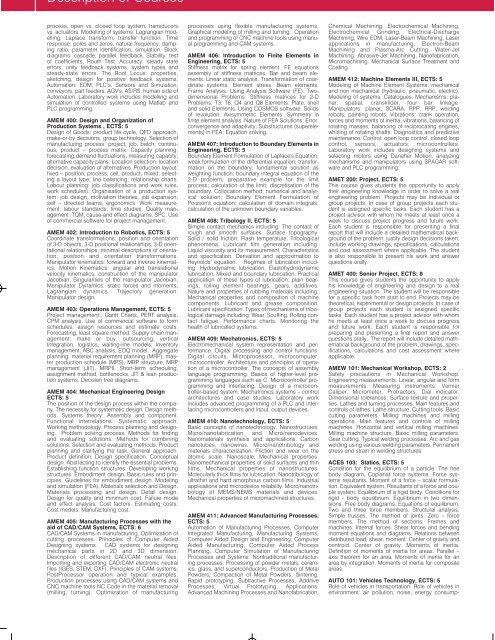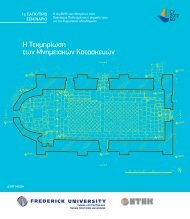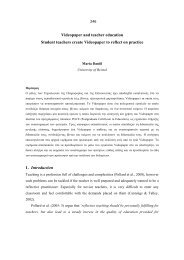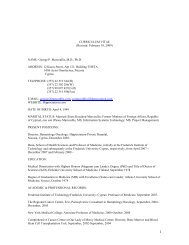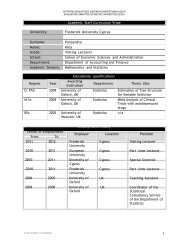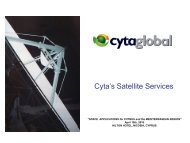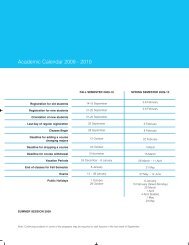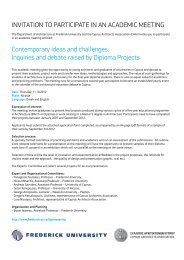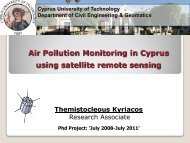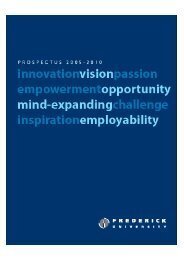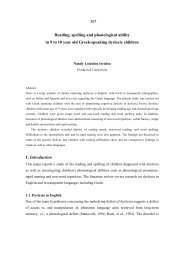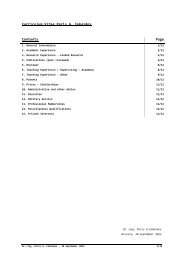Untitled - Frederick University
Untitled - Frederick University
Untitled - Frederick University
Create successful ePaper yourself
Turn your PDF publications into a flip-book with our unique Google optimized e-Paper software.
Description of Courses<br />
process, open vs. closed loop system, transducers<br />
vs. actuators. Modelling of systems: Lagrangian modelling,<br />
Laplace transform, transfer function. Time<br />
response: poles and zeros, natural frequency, damping<br />
ratio, parameter identification, simulation. Block<br />
diagrams: cascade, parallel, feedback. Stability: test<br />
of coefficients, Routh Test. Accuracy: steady state<br />
errors, unity feedback systems, system types and<br />
steady-state errors. The Root Locus: properties,<br />
sketching, design for positive feedback systems.<br />
Automation: EDM, PLC’s, Sensors and Simulation,<br />
conveyors, part feeders, AGV's, AS/RS, human side of<br />
Automation. Laboratory work includes modelling and<br />
simulation of controlled systems using Matlab and<br />
PLC programming.<br />
AMEM 400: Design and Organization of<br />
Production Systems , ECTS: 5<br />
Design of Goods: product life cycle, QFD approach,<br />
make-or-by decisions, group technology. Selection of<br />
manufacturing process: project, job, batch, continuous,<br />
product – process matrix. Capacity planning:<br />
forecasting demand fluctuations, measuring capacity,<br />
alternative capacity plans. Location selection: location<br />
decision, evaluation of alternatives. Production layout:<br />
fixed – position, process, cell, product, mixed; selecting<br />
a layout type; line balancing; relationship charts.<br />
Labour planning: job classifications and work rules,<br />
work schedules). Organisation of a production system:<br />
job design, motivation theories, job expansion,<br />
self – directed teams, ergonomics. Work measurement:<br />
labour standards, time studies. Quality management:<br />
TQM, cause-and effect diagrams, SPC. Use<br />
of commercial software for project management.<br />
AMEM 402: Introduction to Robotics, ECTS: 5<br />
Coordinate transformations: position and orientation<br />
of 3-D objects, 3-D positional relationships, 3-D orientational<br />
relationships, minimal descriptions of orientation,<br />
position and orientation transformations.<br />
Manipulator kinematics: forward and inverse kinematics.<br />
Motion Kinematics: angular and translational<br />
velocity kinematics, construction of the manipulator<br />
Jacobian, Singularities of the manipulator Jacobian.<br />
Manipulator Dynamics: static forces and moments,<br />
Lagrangian dynamics. Trajectory generation.<br />
Manipulator design.<br />
AMEM 403: Operations Management, ECTS: 5<br />
Project management:, Gantt Charts, PERT analysis,<br />
CPM analysis. Use of commercial software to form<br />
schedules, assign resources and estimate costs.<br />
Forecasting, least square method. Supply chain management:<br />
make or buy, outsourcing, vertical<br />
Integration, logistics, waiting-line models. Inventory<br />
management, ABC analysis, EOQ model. Aggregate<br />
planning: material requirement planning (MRP), master<br />
production schedule (MPS), MRP structure, MRP<br />
management (JIT), MRPII. Short-term scheduling,<br />
assignment method, bottlenecks. JIT & lean production<br />
systems. Decision tree diagrams.<br />
AMEM 404: Mechanical Engineering Design<br />
ECTS: 5<br />
The position of the design process within the company.<br />
The necessity for systematic design. Design methods.<br />
Systems theory. Assembly and component.<br />
Functional interrelations. Systematic approach.<br />
Working methodology. Process planning and designing.<br />
Problem solving process. Methods for finding<br />
and evaluating solutions. Methods for combining<br />
solutions. Selection and evaluating methods. Product<br />
planning and clarifying the task. General approach.<br />
Product definition. Design specification. Conceptual<br />
design. Abstracting to identify the essential problems.<br />
Establishing function structures. Developing working<br />
structures. Embodiment design. Basic rules and principles.<br />
Guidelines for embodiment design. Modeling<br />
and simulation (FEA). Materials selection and Design.<br />
Materials processing and design. Detail design.<br />
Design for quality and minimum cost. Failure mode<br />
and effect analysis. Cost factors. Estimating costs.<br />
Cost models. Manufacturing cost.<br />
AMEM 405: Manufacturing Processes with the<br />
aid of CAD/CAM Systems, ECTS: 6<br />
CAD/CAM Systems in manufacturing. Optimization of<br />
cutting processes. Principles of Computer Aided<br />
Designing systems. CAD systems for designing<br />
mechanical parts in 2D and 3D dimension.<br />
Description of different CAD/CAM neutral files.<br />
Importing and exporting CAD/CAM electronic neutral<br />
files (IGES, STEM, DXF). Principles of CAM systems,<br />
PostProcessor operation and typical examples.<br />
Production processes using CAD/CAM systems and<br />
CNC machine tools NC Code in the material removal<br />
(milling, turning). Optimization of manufacturing<br />
processes using flexible manufacturing systems,<br />
Graphical modeling of milling and turning. Operation<br />
and programming of CNC machine tools using manual<br />
programming and CAM systems.<br />
AMEM 406: Introduction to Finite Elements in<br />
Engineering, ECTS: 5<br />
Stiffness matrix for spring element. FE equations<br />
assembly of stiffness matrices. Bar and beam elements.<br />
Linear static analysis. Transformation of coordinate<br />
systems; Element stress. Beam elements.<br />
Frame Analysis. Using Analysis Software (FE). Twodimensional<br />
Problems. Stiffness matrices for 2-D<br />
Problems: T3, T6, Q4 and Q8 Elements. Plate, shell<br />
and solid Elements. Using COSMOS software. Solids<br />
of revolution. Axisymmetric Elements. Symmetry in<br />
finite element analysis. Nature of FEA Solutions; Error,<br />
convergence and adaptivity. Substructures (superelements)<br />
in FEA; Equation solving.<br />
AMEM 407: Introduction to Boundary Elements in<br />
Engineering, ECTS: 5<br />
Boundary Element Formulation of Laplace's Equation;<br />
weak formulation of the differential equation; transformation<br />
on the boundary; fundamental solution as<br />
weighting function; boundary integral equation of the<br />
2-D problem; preparative example for the limit<br />
process; calculation of the limit; discretisation of the<br />
boundary. Collocation method; numerical and analytical<br />
solution; Boundary Element Formulation of<br />
Poisson's equation; calculation of domain integrals;<br />
calculation of the unknown boundary variables.<br />
AMEM 408: Tribology II, ECTS: 5<br />
Simple contact mechanics including: The contact of<br />
rough and smooth surfaces. Surface topography.<br />
Solid / solid friction. Flash temperature. Tribological<br />
phenomena. Lubricant film generation including:<br />
Liquid viscosity and its measurement, Characteristics<br />
and specification. Derivation and approximation to<br />
Reynolds’ equation. Regimes of lubrication including:<br />
Hydrodynamic lubrication, Elastohydrodynamic<br />
lubrication, Mixed and boundary lubrication. Practical<br />
application of these types of lubrication; plain bearings,<br />
rolling element bearings, gears, additives.<br />
Nature and properties of rubbing materials including:<br />
Mechanical properties and composition of machine<br />
components. Lubricant and grease composition.<br />
Lubricant specification. Types of mechanisms of tribological<br />
damage including: Wear, Scuffing, Rolling contact<br />
fatigue. Performance charts. Monitoring the<br />
health of lubricated systems.<br />
AMEM 409: Mechatronics, ECTS: 5<br />
Electromechanical system representation and performance.<br />
Digital processing and control functions.<br />
Digital circuits. Microprocessor, microcomputer,<br />
microcontroller. Architecture and principles of operation<br />
of a microcontroller. The concepts of assembly<br />
language programming. Basics of higher-level programming<br />
languages such as C. Microcontroller programming<br />
and interfacing. Design of a microcontroller-based<br />
system. Mechatronics systems – control<br />
architectures and case studies. Laboratory work<br />
includes advanced programming of a PLC and interfacing<br />
microcontrollers and input, output devices.<br />
AMEM 410: Nanotechnology, ECTS: 5<br />
Basic concepts of nanotechnology. Nanostructures,<br />
Micro/nanofabrication, and Micro/nanodevices.<br />
Nanomaterials synthesis and applications. Carbon<br />
nanotubes, nanowires. Micro/nanotribology and<br />
materials characterization. Friction and wear on the<br />
atomic scale. Nanoscale. Mechanical properties.<br />
Nanomechanical properties of solid surfaces and thin<br />
films. Mechanical properties of nanostructures.<br />
Molecularly thick films for lubrication. Nanotribology of<br />
ultrathin and hard amorphous carbon films. Industrial<br />
applications and microdevice reliability. Micro/nanotribology<br />
of MEMS/NEMS materials and devices.<br />
Mechanical properties of micromachined structures.<br />
AMEM 411: Advanced Manufacturing Processes,<br />
ECTS: 5<br />
Automation of Manufacturing Processes, Computer<br />
Integrated Manufacturing, Manufacturing Systems,<br />
Computer Aided Design and Engineering, Computer<br />
Aided Manufacturing, Computer Aided Process<br />
Planning, Computer Simulation of Manufacturing<br />
Processes and Systems. Nontraditional manufacturing<br />
processes. Processing of powder metals, ceramics,<br />
glass, and superconductors, Production of Metal<br />
Powders, Compaction of Metal Powders, Sintering.<br />
Rapid prototyping, Subtractive Processes, Additive<br />
Processes, Virtual Prototyping, Applications.<br />
Advanced Machining Processes and Nanofabrication,<br />
Chemical Machining, Electrochemical Machining,<br />
Electrochemical Grinding, Electrical-Discharge<br />
Machining, Wire EDM, Laser-Beam Machining, Laser<br />
applications in manufacturing, Electron-Beam<br />
Machining and Plasma-Arc Cutting, Water-Jet<br />
Machining. Abrasive-Jet Machining, Nanofabrication,<br />
Micromachining. Mechanical Surface Treatment and<br />
Coating.<br />
AMEM 412: Machine Elements III, ECTS: 5<br />
Modeling of Machine Element Systems: mechanical<br />
and non mechanical (hydraulic, pneumatic, electric).<br />
Modeling of systems. Catalogues. Mechanisms: planar,<br />
spatial, cransklider, four bar linkage.<br />
Manipulators: planar, SCARA, RPP, RRP, welding<br />
robots, painting robots. Vibrations: crank operation,<br />
forces and moments of inertia, vibrations, balancing of<br />
rotating masses, balancing of reciprocating engines,<br />
whirling of rotating shafts. Diagnostics and predictive<br />
maintenance. Control: open loop control, closed loop<br />
control, sensors, actuators, microcontrollers.<br />
Laboratory work includes designing systems and<br />
selecting motors using Danaher Motion, analyzing<br />
mechanisms and manipulators using SPACAR software<br />
and PLC programming.<br />
AMET 200: Project, ECTS: 5<br />
This course gives students the opportunity to apply<br />
their engineering knowledge in order to solve a real<br />
engineering problem. Projects may be individual or<br />
group projects. In case of group projects each student<br />
is assigned specific tasks. Each student has a<br />
project advisor with whom he meets at least once a<br />
week to discuss project progress and future work.<br />
Each student is responsible for presenting a final<br />
report that will include a detailed mathematical background<br />
of the problem, justify design decisions taken,<br />
include working drawings, specifications, calculations<br />
and cost assessment where applicable. The student<br />
is also responsible to present his work and answer<br />
questions orally.<br />
AMET 400: Senior Project, ECTS: 8<br />
This course gives students the opportunity to apply<br />
his knowledge of engineering and design to a real<br />
engineering situation. The student will be responsible<br />
for a specific task from start to end. Projects may be<br />
theoretical, experimental or design projects. In case of<br />
group projects each student is assigned specific<br />
tasks. Each student has a project advisor with whom<br />
he meets at least once a week to discuss progress<br />
and future work. Each student is responsible for<br />
preparing and presenting a final report and answer<br />
questions orally. The report will include detailed mathematical<br />
background of the problem, drawings, specifications,<br />
calculations and cost assessment where<br />
applicable.<br />
AMEW 101: Mechanical Workshop, ECTS: 2<br />
Safety precautions in Mechanical Workshop.<br />
Engineering measurements. Linear, angular and form<br />
measurements. Measuring instruments: Vernier<br />
Caliper, Micrometer, Protractors, Dial indicator.<br />
Dimensional tolerances. Surface texture and properties.<br />
Lathes and turning processes. Main features and<br />
controls of lathes. Lathe structure, Cutting tools. Basic<br />
cutting parameters. Milling machines and milling<br />
operations. Main features and controls of milling<br />
machines. Horizontal and vertical milling machines.<br />
Milling machine structure. Basic milling parameters.<br />
Gear cutting. Typical welding processes. Arc and gas<br />
welding using various welding parameters. Permanent<br />
stress and strain in welding structures.<br />
ACES 103: Statics, ECTS: 5<br />
Condition for the equilibrium of a particle. The free<br />
body diagram, Coplanar force systems. Force systems<br />
resultants. Moment of a force – scalar formulation.<br />
Equivalent system. Resultants of a force and couple<br />
system. Equilibrium of a rigid body. Conditions for<br />
rigid - body equilibrium. Equilibrium in two dimensions.<br />
Free body diagrams. Equations of equilibrium.<br />
Two and three force members. Structural analysis.<br />
Simple trusses. The method of joints. Zero – force<br />
members. The method of sections. Frames and<br />
machines. Internal forces. Shear forces and bending<br />
moment equations and diagrams. Relations between<br />
distributed load, shear, moment. Center of gravity and<br />
centroid. Center of gravity. Moments of inertia.<br />
Definition of moments of inertia for areas. Parallel –<br />
axis theorem for an area. Moments of inertia for an<br />
area by integration. Moments of inertia for composite<br />
areas.<br />
AUTO 101: Vehicles Technology, ECTS: 5<br />
Role of vehicles in transportation. Role of vehicles in<br />
environment: air pollution, noise, energy consump-


